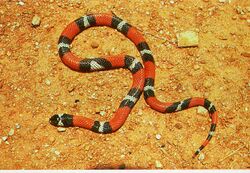Biology:Erythrolamprus aesculapii
| Erythrolamprus aesculapii | |
|---|---|

| |
| Scientific classification | |
| Domain: | Eukaryota |
| Kingdom: | Animalia |
| Phylum: | Chordata |
| Class: | Reptilia |
| Order: | Squamata |
| Suborder: | Serpentes |
| Family: | Colubridae |
| Genus: | Erythrolamprus |
| Species: | E. aesculapii
|
| Binomial name | |
| Erythrolamprus aesculapii | |
| Synonyms[3] | |
Erythrolamprus aesculapii, also known commonly as the Aesculapian false coral snake, the South American false coral snake, and in Portuguese as bacorá, or falsa-coral, is a species of mildly venomous snake in the family Colubridae. The species is endemic to South America.[4]
Etymology
The specific name, aesculapii, refers to Aesculapius, the Greek mythological god of medicine, who is depicted with a snake-entwined staff.[5]
Geographic range
E. aesculapii is found in the Amazon rainforest of South America.[4][6] It is also found on the island of Trinidad (in the Republic of Trinidad and Tobago).[7]
Habitat and behavior
E. aesculapii is often found in the leaf litter or burrowing in the soil in rain forests,[4] at altitudes from sea level to 2,300 m (7,500 ft).[1]
Diet
E. aesculapii feeds mainly on other snakes, including venomous species.[4] It will also prey on lizards, fish and earthworms.[8] Insects are probably consumed though secondary ingestion.[9]
Venom
E. aesculapii is mildly venomous.[7]
Mimicry
The brightly colored, ringed patterns of snakes of the genus Erythrolamprus resemble those of sympatric coral snakes of the genus Micrurus, and it has been suggested that this is due to mimicry. Whether this is classical Batesian mimicry, classical Müllerian mimicry, a modified form of Müllerian mimicry, or no mimicry at all, remains to be proven.[10]
Subspecies
The following four subspecies are recognized as being valid, including the nominotypical subspecies:[2]
- Erythrolamprus aesculapii aesculapii (Linnaeus, 1758) – Amazon River Basin
- Erythrolamprus aesculapii monozonus Jan, 1863 – Brazil (Bahia state to Rio de Janeiro state)
- Erythrolamprus aesculapii tetrazonus Jan, 1863 – southwestern Bolivia
- Erythrolamprus aesculapii venustissimus (Wied, 1821) – eastern Bolivia to southeastern Brazil and northeastern Argentina [4]
References
- ↑ 1.0 1.1 Ines Hladki A, Ramírez Pinilla M, Renjifo J, Urbina N, Nogueira C, Gagliardi G, Cisneros-Heredia DF, Catenazzi A, Gonzales L, Schargel W, Rivas G, Murphy J (2019). "Erythrolamprus aesculapii ". The IUCN Red List of Threatened Species 2019: e.T203509A2766817. https://dx.doi.org/10.2305/IUCN.UK.2019-3.RLTS.T203509A2766817.en.Downloaded on 13 March 2021.
- ↑ 2.0 2.1 "Erythrolamprus aesculapii ". ITIS (Integrated Taxonomic Information Sysyem). www.itis.gov.
- ↑ Boulenger GA (1896). Catalogue of the Snakes in the British Museum (Natural History). Volume III., Containing the Colubridæ (Opisthoglyphæ and Proteroglyphæ),... London: Trustees of the British Museum (Natural History). (Taylor and Francis, Printers.) xiv + 727 pp. + Plates I-XXV. (Erthrolamprus æsculapii, pp. 200-204).
- ↑ 4.0 4.1 4.2 4.3 4.4 Freiberg M (1982). Snakes of South America. Hong Kong: T.F.H. Publications. 189 pp. ISBN:0-87666-912-7. (Erythrolamprus aesculapii, pp. 66, 98, 132 + photograph on p. 42 + line drawing of head scalation on p. 67).
- ↑ Beolens B, Watkins M, Grayson M (2011). The Eponym Dictionary of Reptiles. Baltimore: Johns Hopkins University Press. xiii + 296 pp. ISBN:978-1-4214-0135-5. (Erythrolamprus aesculapii, p. 2).
- ↑ "Amphibians and reptiles of Guyana, South America: Illustrated keys, annotated species accounts, and a biogeographic synopsis". Proceedings of the Biological Society of Washington 125 (4): 317–620. 2013. doi:10.2988/0006-324x-125.4.317.
- ↑ 7.0 7.1 Erythrolamprus aesculapii at the Reptarium.cz Reptile Database. Accessed 25 August 2014.
- ↑ "Aesculapian False-Coralsnake (Erythrolamprus aesculapii)". https://www.reptilesofecuador.com/erythrolamprus_aesculapii.html.
- ↑ "Aesculapian False-Coralsnake (Erythrolamprus aesculapii)". https://www.reptilesofecuador.com/erythrolamprus_aesculapii.html.
- ↑ Goin CJ, Goin OB, Zug GR (1978). Introduction to Herpetology, Third Edition. San Francisco: W.H. Freeman. xi + 378 pp. ISBN:0-7167-0020-4. (Mimicry in Erythrolamprus, p. 159).
Further reading
- Boos, Hans E. A. (2001). The Snakes of Trinidad and Tobago. College Station, Texas: Texas A&M University Press. xvi + 328 pp.. ISBN 1-58544-116-3.
- Linnaeus L (1758). Systema naturæ per regna tria naturæ, secundum classes, ordines, genera, species, cum characteribus, differentiis, synonymis, locis. Tomus I. Editio Decima, Reformata. Stockholm: L. Salvius. 824 pp. (Coluber æsculapii, new species, p. 220). (in Latin).
- Wickler, Wolfgang (1968). Mimicry in Plants and Animals. McGraw-Hill Book Company. https://archive.org/details/mimicryinplantsa00wick.
Wikidata ☰ Q2710586 entry
 |


